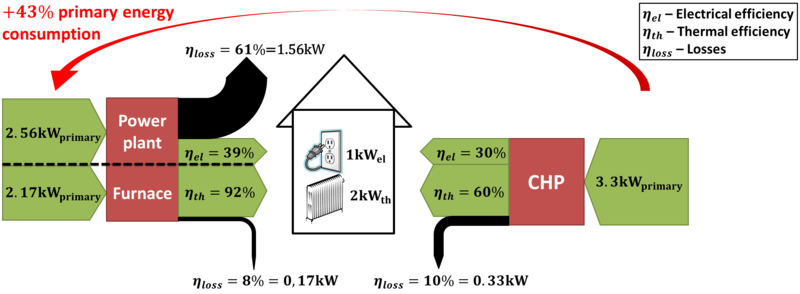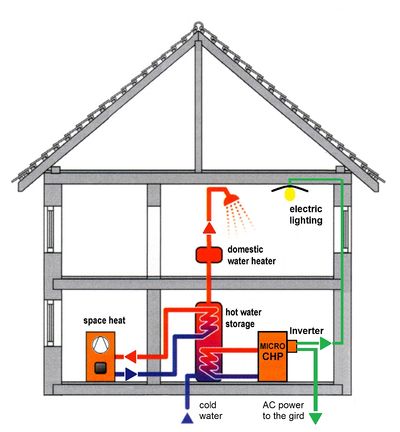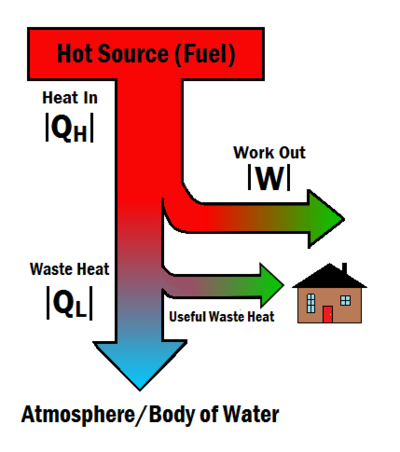Cogeneration
Cogeneration or combined heat and power (CHP) is the on-site generation of electricity and useful heat. When generating electricity from coal, natural gas or nuclear power only a fraction of the actual energy content released during combustion is converted into electricity. The remainder of the energy is lost as waste heat. In a CHP power plant, this waste heat is recovered for other applications such as space heating or other industrial processes that require heat. Hence, CHP is an efficient process to recover energy that would have otherwise been lost.[1] Due to this increase in efficiency, cogeneration has many environmental benefits and can be a key factor in reducing climate change.[2]
Cogeneration plants offer large cost savings, providing additional competitiveness for industrial and commercial users, and offering affordable heat for domestic users.[1] They provide clear environment benefits due to their enhanced conversion of energy and use of waste heat, however there are many roadblocks in building such plants.[3] First of all, the initial start-up costs are relatively high which can ward off many potential developers. The second, and biggest roadblock is utilities and regulators scaring off the building of such projects. Cogeneration plants are a threat to such companies, and there have been known to be many legal wranglings in the development of these plants.[4] On the other hand, distributed generation sources of electricity can create electrocution hazards for the power company by electrifying a portion of the electrical grid that would otherwise be off when the company needs to work on that portion of the grid.
Also, when used with a fossil fuel input source, CHP cannot be considered an ultimately sustainable solution for the long term. However, it can help slow the rate of carbon emissions with substantial energy savings in situations where more sustainable options are not available or affordable.[5]
A discussion of some of the pros and cons of CHP can be seen on the blog TriplePundit here.
Efficiency
Traditionally, homes are heated with furnaces and electricity comes from power plants. In combustion-based energy generation systems (or nuclear systems), whether it is a gas turbine or a combustion engine, the efficiency is limited by thermodynamics, and energy is lost as waste heat. The total loss is the sum of the losses in both heat and power generation. Hence, the total efficiency is low.
Producing the equivalent amount of heat and electricity using a CHP system is much more efficient as heat from electricity production can be usefully applied. The total efficiency of a CHP system is then given by the sum of its electrical and thermal efficiency. Only a tiny portion of the heat is unrecoverable, and still lost as waste heat.

Efficiency calculations
A household has a specific thermal energy demand , and a power demand
. The CHP has a thermal efficiency
, and an electrical efficiency
. Due to combined generation, the CHP efficiency is the sum of these efficiencies
, where the total fuel needed to meet the house's needs is
. Due to the much higher efficiency of
compared to a household not using CHP, the amount of fuel needed to meet its energy needs is much less. For example if a house using CHP has an efficiency of 90%, compared to a house running at 30% efficiency, it will only need to use 1/3 the amount of fuel to fulfill its needs![7]
Types

For cogeneration units, first of all it is distinguished between the system size based on its electrical output. Typically Micro-CHP will output less than 5 kilowatt (kW) while Mini-CHP will be greater than 5 kW and less than 500 kW. Micro-CHP systems are usually installed in homes and are heat demand controlled. This means that they turn on when there is a need for heat to produce the by-product heat while generating electricity.
The different types of Micro-CHP systems include for example:
Integrating CHP in the electricity grid
To integrate a CHP system onto the grid, it must first be connected to an inverter to convert DC electricity to AC electricity. This allows the generated electricity to be used by others on the grid. A high penetration rate of micro-CHP systems in homes has the potential to cause instabilities to the electrical grid. This is due to the difficulty in forecasting when these systems will generate electricity as they must be producing heat in the home in order to obtain the electricity required for the load. At peak hours when the electricity consumption is high, there is a greater need for additional electricity on the electric grid than in off-peak hours. Areas of interest addressing this issue include heat storage which may effectively make the CHP become electricity demand controlled instead of heat demand controlled. The system would generate electricity as required by the grid and store excess heat for use at another time.
To learn more about the benefits and applications of CHP, visit the EPA's information page.
References
- ↑ 1.0 1.1 COGEN, What is cogeneration? [Online], Available: http://www.cogeneurope.eu/what-is-cogeneration_19.html
- ↑ Code Project, Cogeneration Case Studies Handbook [Online], Available: http://www.code-project.eu/wp-content/uploads/2011/04/CODE_CS_Handbook_Final.pdf
- ↑ IEA. (2014). Linking Heat and Electricity Systems [Online]. Available: https://www.iea.org/publications/freepublications/publication/LinkingHeatandElectricitySystems.pdf
- ↑ Forbes, The Most Efficient Power Plants [Online], Available: http://www.forbes.com/2008/07/03/energy-efficiency-cogeneration-biz-energy_cx_jz_0707efficiency_horror.html
- ↑ Triple Pundit, Combined Heat and Power: Pros and Cons [Online], Available: http://www.triplepundit.com/special/energy-options-pros-and-cons/combined-heat-power-pros-cons/
- ↑ Agert, Prof. Dr. Carsten, Energy Storage Lecture 4, Storing heat instead of electricity, unpublished.
- ↑
- ↑ Oakland University. (2013) Energy System Applications & Integration Lab (ESAIL). [Online]. Available: http://www.oakland.edu/ESAIL.


